This week, Soundgarden’s 1989 album Louder Than Love is being treated to a vinyl reissue, as it deserves to be. The band’s major label debut—after releasing material on the prominent indie labels Sub Pop and SST—Louder Than Love cemented the up-and-coming Seattle band’s instantly familiar yet radical mix of hard-rock traditionalism and post-punk attitude. Naturally, Louder Than Love is being hailed for this reissue as a grunge milestone. Seeing as how it appeared a full two years before Nirvana’s major label debut, Nevermind, there’s no countering that argument. But there’s something else Louder Than Love should be hailed as: one of the milestones of alternative metal.Grunge often gets called the nail in the coffin of 80s hair metal, but if that’s the case, alternative metal built the coffin. As a once vital and exciting crop of glam bands in the early 80s got watered down into gruel by the end of the decade, a disparate bunch of bands rose to fill the void. Faith No More mixed rap and synthesizers into their riffs; The Cult brought a dark, Doors-y vibe to their retroactive rock; Primus put a cartoony, virtuosic, Zappa-like spin on things; and King’s X’s melodic, progressive songs were grab-bag of styles and sounds.Some of these groups had been around for years before getting tagged as alternative metal in the late 80s, a label that never really became popular. On a larger scale, Metallica and Guns N’ Roses were already digging an escape route out of the hair-metal purgatory American metal found itself in, but alternative metal was something else entirely: a loose confederation of oddballs, misfits, artists, and colorful characters whose anything-goes ethos fit better with the rising tide of alternative rock, which was just starting to make massive commercial inroads with R.E.M. and The Cure.
Alternative metal came into its own, though, thanks to the success of a handful of groups in the late 80s. Living Colour’s Vivid, Jane’s Addition’s Nothing’s Shocking, Red Hot Chili Peppers’ Mother’s Milk, and Faith No More’s The Real Thing came out in 1988 and 1989, and they redrew the metal blueprint. None of them played metal in a strict sense; everything from goth to folk to funk to art-rock popped up on these albums, and they were more apt to sing poetry or politics than the tried-and-true metal topics of sex, drugs, and rock ’n’ roll. But for an audience weary of hair-metal’s decreasing returns—'88 and ’89 being the age where Warrant, Winger, and Slaughter reigned supreme—the vibrancy and diversity of alternative metal was a breath of fresh air.That said, skaters and college kids were much more likely to rock out to alternative metal than your average headbanger in the late 80s. But some bands lumped into the alternative metal category had one foot squarely in the metal camp—most notably Queensrÿche and Voivod. Both groups openly expressed their love of science fiction, which imbued their music with a geek-inclusive mystique that hadn’t been seen since the heyday of progressive rock in the ’70s. Indeed, both Queensrÿche and Voivod felt like new, heavy-metal incarnations of Pink Floyd than anything else; Voivod even covered Pink Floyd’s “Astronomy Domine,” whose video saw plenty of play on MTV’s Headbanger’s Ball in 1989.Headbanger’s Ball gave a needed boost to alternative metal on those pre-Nevermind months, but it was Soundgarden that inadvertently waved the banner. No one embraced the tag of alternative rock at the time; as genre names go, it’s vague and clumsy. As a way to draw in new audiences, though, it didn’t hurt. Neither did the strength of Louder Than Love. Soundgarden had been releasing music since 1986, when two of their songs appeared on the seminal Seattle compilation Deep Six (alongside, among others, the Melvins, another band lumped briefly into the alternative metal category before establishing the band as a category unto itself). But Louder Than Love honed Soundgarden’s seamless blend of metal roots and forward-thinking weirdness, from the menacing psychedelic undertow of “Hands All Over” to the Zeppelin-esque stomp of “Loud Love.” Kim Thayil’s riffs lurched like wounded dinosaurs, and in Chris Cornell, alternative metal had a burgeoning, bona fide rock star with the potential to rival—if not displace—all the Kip Wingers and Sebastian Bachs of the world.
But was it metal? Thayil didn’t think so. As quoted in Ian Christe’s book Sound of the Beast, the Soundgarden guitarist “hated heavy metal for years. […] I thought it stood for everything I hated about the rock industry and all the jocks, musicians, and jerks in high school.” He went on to add, “Some people think heaviness is distortion, loud volume, or kicking drums. They may all have a place in warranting a heavy sound, but above all it’s got to be mind-bending.” This sentiment was echoed later by John Stanier, drummer of Helmet, one of the most powerful bands to have been slapped with the alternative metal label in the early 90s. “We fell into the whole metal thing by accident,” Stanier says in Sound of the Beast. “We always hated it when people mentioned metal in conjunction with us.” But that was the whole point of alternative metal; purity and authenticity were rejected as false premises, while a freer synthesis of styles, approaches, and attitudes was the only rule.By the time the 90s rolled around, the seeds of grunge had sprouted—and they’d done so in the soil of alternative metal. Nirvana’s debut album Bleach may have come out in 1989, but it had little impact outside the underground; meanwhile, fellow Seattle bands Mother Love Bone, Alice in Chains, and Soundgarden were releasing dark, brooding, heavy albums on major labels. They didn’t sell all that much, but they started a collective buzz, helping to prime listeners for the widespread acceptance of Nirvana when Nevermind hit like a brick in 1992.
“Smells Like Teen Spirit” didn’t happen in a vacuum; Soundgarden’s Louder Than Love and Alice in Chain’s Facelift had already sparked the hunger for heavy music that was subversive, mysterious, cryptic, and challenging. And, yes, from Seattle. And after Nirvana’s ascendancy to godhood, Soundgarden and Alice in Chains were removed from the alternative metal column and placed front and center in a new marketing brand that the music industry appropriated from the underground: grunge. It was far more lucrative, but far more restrictive.The term “alternative metal” still pops up from time to time, but it’s no more relevant or meaningful today than “alternative rock.” Instead, it’s a relic. But the brief, nebulous era of alternative metal in the late 80s and early 90s remains a snapshot of a vibrant time when a brash new generation of heavy-leaning bands threw everything against the wall to see what stuck. Ultimately alternative metal was an imperfect, arbitrary, and ultimately cynical tag, a desperate attempt to find a marketing niche and identifiable brand for metal at a time when metal, at least on a mainstream level, was withering. But it also gave a boost to many good bands that might otherwise have foundered along without support or visibility, and in a way it helped pave the way for a crop of bands that rose to prominence immediately after grunge, from Tool to Neurosis. Alternative metal, flawed though it was, showed the world that heavy music had more life, vitality, color, and imagination to it than anyone during the hair metal regime ever dreamed.
Jason Heller is flying the alt flag on Twitter.
Advertisement
 Living Colour / Photo courtesy of the artist
Living Colour / Photo courtesy of the artist
Advertisement
 Jane's Addiction / Photo courtesy of the artist
Jane's Addiction / Photo courtesy of the artist Alice in Chains / Photo courtesy of the artist
Alice in Chains / Photo courtesy of the artist